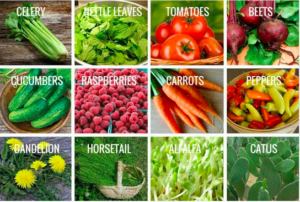Silica
 Silicon: This much neglected element is needed for strong yet flexible bones and healthy cartilage, connective tissue, skin, hair and nails. In the blood vessels, the presence of adequate silicon helps prevent atherosclerosis. Silicon also protects against toxic aluminum. Good sources are grains with shiny surfaces, such as millet, corn and flax, the stems of green vegetables and homemade bone broths in which chicken feet or calves’ feet have been included.
Silicon: This much neglected element is needed for strong yet flexible bones and healthy cartilage, connective tissue, skin, hair and nails. In the blood vessels, the presence of adequate silicon helps prevent atherosclerosis. Silicon also protects against toxic aluminum. Good sources are grains with shiny surfaces, such as millet, corn and flax, the stems of green vegetables and homemade bone broths in which chicken feet or calves’ feet have been included.
Which foods are a source of silica?
Food sources of silica include:5,6
- wholegrains
- green beans
- rice
- cucumbers
- tomatoes
Silica is available as tablets and caplets, often extracted from horsetail herb.
Benefits of silica
More research is needed to fully understand silica’s role in our body, but it’s thought to have the following effects:
It can support bone formation and maintenance
Although calcium and vitamin D get most of the attention when it comes to bone health, a 2013 study in International Journal of Endocrinology reported that silica can increase bone mineral density and strength. The researchers think silica is needed to trigger the deposit of bone crystals, a procedure known as bone mineralisation.7
It may help make collagen
A 2016 study by Sao Paulo University, Brazil reported that silica helps form the building blocks of collagen, an important protein found in your skin, blood, cartilage, muscles and ligaments.
Collagen is needed to keep skin springy and elastic, and provide crucial protection and structure to your organs and joints.8,9 In one study of women with sun-damaged skin, those who took 10mg of silica daily for 20 weeks had decreased skin roughness and wrinkling, and also stronger, less brittle hair and nails.10
It may also help your heart and immune system
Silica may help protect your heart health by reducing the risk of atherosclerosis, or hardening of the arteries, while lowering cholesterol, according to a 2018 report by the University of Memphis. The mineral can also support the immune response, and help to control inflammation in the body.11
Dosage
How much silica is safe to take?
The upper safe limit has been reported as 700–1,750 mg a day. As silica is water-soluble, excess is simply passed out by the body in your urine, meaning it’s unlikely to cause side effects if you take too much.12
Silica should be avoided by the following people:
- children – horsetail contains traces of nicotine13
- pregnant women – it has not been proved safe for them
- people with kidney disease – they may accumulate silica in their bloodstream14
What are the side-effects of taking silica?
Silica is considered safe for healthy people.15 However, if you decide to get your silica from horsetail herb supplements, be aware that this is not a herb to be used continuously on a long-term basis as it may cause stomach upsets.
The herb’s other actions also mean you need to be careful. For example, horsetail acts as a diuretic so can flush potassium out of the body,16 which may interfere with certain medications and can lead to problems with your heart rhythm.17
It also contains an enzyme called thiaminase, which destroys vitamin B1 (thiamine) and can cause symptoms of neurological toxicity in people who are already thiamine-deficient.18
Some horsetail supplements have the thiaminase removed. Otherwise, it may be a good idea to take a good quality vitamin B complex supplement or multivitamin if you take horsetail, or to get advice from your doctor.
Horsetail herb can cause the following side effects:19
- allergic reactions, for example rash and swelling of the face
- upset stomach
- hypoglycemia in people with diabetes20
However, before you take silica, always check with your doctor if you have a long-term condition or are on any medication
What is silica and what does it do?
Silica is a natural compound, found all around us in nature. Silica makes up over a quarter of the planet’s crust and can be found in most rocks, clays and sands. Its forms include emerald, quartz, clay and glass. Silica has multiple uses in industry – for example, in concrete – and in foods, including as an anti-caking agent.1 In short, it’s everywhere – but how exactly can it help your health?
Although it’s now known to be an important trace element, historically silica’s actually been considered more harmful than helpful to our health – for example, it’s known that when inhaled in its crystalline form, over time, silica can cause serious lung disease.2 But silica comes in many forms.
There’s lots of evidence that its water-soluble form, which is found in certain plants – including the herb horsetail3 – is highly beneficial to health. Traditionally, horsetail has been used to treat wounds, strengthen connective tissue and support the kidneys.4
